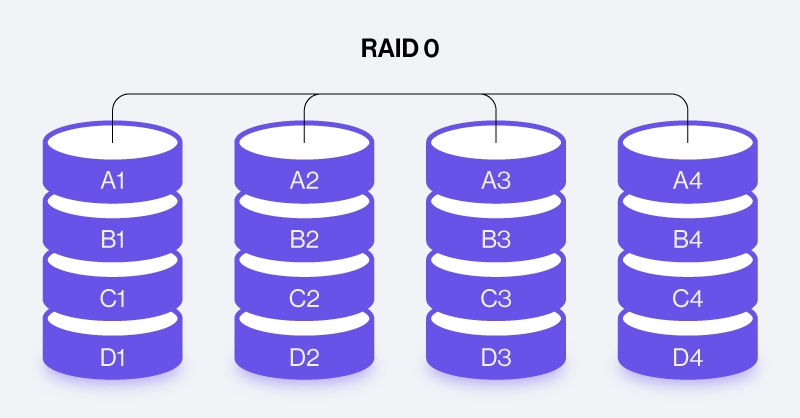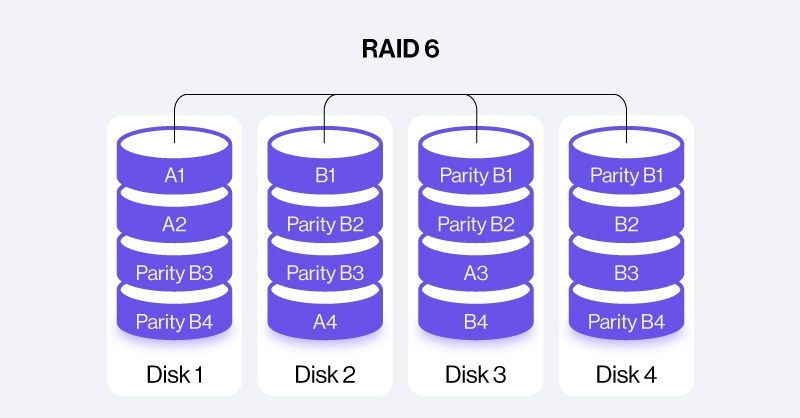Understanding RAID
RAID (Redundant Array of Independent Disks) is a data storage technology that provides redundancy and fault tolerance or speed in data centers. It utilizes multiple physical hard drives and enhances performance, reliability, and/or data protection with clever data allocation. RAID configurations distribute data across the drives in different ways, offering various levels of redundancy or speed.
For simplicity sake, we will use an example of a 4TB four-drive storage server with hypothetical read and write speeds: 4x 1TB Hard Drives with 150 MB/s read and 150 MB/s write speeds each. Explore our hard drive offerings for options for expanding your home lab or storage infrastructure. Here is a table on the overview of pros, cons, and use case.
4x 1TB HDDs with 150 MB/s Read and Write Speeds
RAID 0 | RAID 1 | RAID4 | RAID 5 | RAID6 | RAID 10 | |
Minimum Drives Required | 2 Drives | 2 Drives | 3 Drives | 3 Drives | 4 Drives | 4 Drives |
Usable Capacity | 4TB | 1TB | 3TB | 3TB | 2TB | 2TB |
Read Speed | 600 MB/s | 600 MB/s | 450 MB/s | 450 MB/s | 450 MB/s | 300 MB/s |
Peak Write Speed | 600 MB/s | 150 MB/s | 450 MB/s | 450 MB/s | 450 MB/s | 300 MB/s |
Worst-Case Write Speed | 600 MB/s | 150 MB/s | 37.5 MB/s | 37.5 MB/s | 25 MB/s | 150 MB/s |
Fault Tolerance | None | 3 Drives | 1 Drive | 1 Drive | 2 Drives | Up to 2 Drives |
Advantages | Fastest read and write | Best redundancy | Dedicated parity drive for simplicity | Balanced performance & redundancy | Better redundancy | Good speed, |
Disadvantages | No redundancy. One drive failure | Highly reduced capacity | Writes speed to parity drive bottleneck | Below average random write speed | Complex with low write speed | Requires 4 drives minimum |
AID 0: Striping
In a RAID 0 configuration, all four drives will have a portion of the data without any redundancy. All data is striped across all the disk drives allowing for simultaneous reading and writing combined of all the disks.
To explain striping, let’s consider our 4-drive storage system and we want to store Project A. Instead of a single drive storing all of Project A’s data, each of the 4 drives will have a portion of Project A, say blocks A1 through A4. When reading Project A, all 4 drives work simultaneously to deliver their blocks of data to their destination. This is true for all data stored in our storage system.
- Usable Capacity: 4TB
- Read Speed: 600 MB/s (150MB/s per 4 drives)
- Write Speed: 600 MB/s (150MB/s per 4 drives)
- Redundancy/Fault Tolerance: None - If one drive fails, all data is lost.
RAID 0 is rarely used in important application workloads and is only used when the data stored on it is temporary or easily replaceable. Because of the higher performance reading and writing speeds, it is used predominantly by consumers and never by businesses. RAID 0 is good for running applications, storing temporary data (for video editing, etc.), and game installations/launchers. However, RAID 0 is used in conjunction with other RAID configurations to increase speed.

RAID 1: Mirroring for Data Redundancy
RAID 1, also known as disk mirroring, involves creating an exact copy (mirror) of data to each of the other drives. Every write operation is simultaneously written to the other drives, ensuring decent fault tolerance and no rebuild times.
RAID 1 provides high redundancy but sacrifices storage capacity since the storage system’s drive capacity is limited to the smallest drive size. RAID 1 is often only used when there are 2 drives in the storage system.
- Minimum Drives: 2 Drives
- Usable Capacity: 1TB
- Read Speed: 600 MB/s (150 MB/s per drive)
- Write Speed: 150 MB/s (same as a single drive)
- Redundancy/Fault Tolerance: Up to 3 drives.

RAID 4: Dedicated Parity for Scalability and Performance
In RAID 4, data is striped across multiple drives with a single dedicated storage drive for storing parity information. Parity information is used as a calculation for reconstructing data in the event of a drive failure (other than the parity drive itself). Think of RAID 4 as a similar deployment as RAID 0 but with fault tolerance! RAID 4 requires at least 4 drives.
In RAID 4, the parity drive can fail and will not affect data loss. Furthermore, failure on a storage drive will require rebuilding with parity information which can take time.
- Usable Capacity: 3TB
- Read Speed: 450 MB/s (150 MB/s per non-parity drive)
- Write Speed:
- Up to 450 MB/s on ideal large sequential write workloads
- As low as 37.5 MB/s on worst-case small random write workloads
- Redundancy/Fault Tolerance: 1 drive.
While RAID 4 may seem a good choice, the write performance is misleading. Large file sequential writes are the ideal scenario but if the workload incorporates smaller random writes, the single parity drive becomes the bottleneck for data transfers. In the worst-case scenario, small random write speeds can be as low as 37.5 MB/s due to parity overhead.
However, RAID 4 has the advantage of adding additional drives to the storage system and parity calculations will only be written to the dedicated parity drive as opposed to a recalculation f distributed parity found in RAID 5. Only one drive failure can happen before catastrophic loss.

RAID 5: Distributed Parity for Performance and Redundancy
RAID 5 stripes data and parity information across multiple drives, along. Parity information is used to reconstruct data in case of a drive failure. Unlike RAID 1, RAID 5 offers a better balance between redundancy, storage capacity, and speed. It requires a minimum of three drives, with the parity information distributed across all drives. In the event of a drive failure, the missing data can be calculated using the parity information. This recovery period can take time, leaving other drives vulnerable.
- Usable Capacity: 3TB
- Read Speed: 450 MB/s (150MB/s per 7 usable drives)
- Write Speed:
- Up to 450 MB/s on ideal large sequential write workloads
- As low as 37.5 MB/s on worst-case small random write workloads
- Redundancy/Fault Tolerance: 1 drive failure
RAID 5 is the more popular and foolproof configuration versus RAID 4. Striping data across all 4 drives allows for faster read performance and write performances that don’t suffer as much when performing small random writes. In the worst-case scenario, small random write speeds are around 37.5 MB/s to 200 MB/s due to parity overhead.

RAID 6: Dual Parity for Increased Fault Tolerance
RAID 6 builds upon RAID 5 by adding an additional level of redundancy. It uses dual parity information distributed across the drives, providing fault tolerance even if two drives fail simultaneously. RAID 6 requires a minimum of four drives and offers enhanced data protection and fault tolerance compared to RAID 5. However, it comes with a tradeoff of reduced write performance due to the additional parity calculations.
- Usable Capacity: 8TB
- Read Speed: 900 MB/s (150MB/s per 6 usable drives)
- Write Speed: Up to 900 MB/s (150MB/s per 6 usable drives )
- Redundancy/Fault Tolerance: 2 drive failures
RAID 6 is a more robust and fault-tolerant version of RAID 5. However, due to the additional parity calculations, write performance also suffers in nonsequential operations. At RAID 6’s worst-case small random write scenario, expect a write performance of 25 MB/s to 150 MB/s.

RAID 10: Combining Mirroring and Striping
RAID 10, also known as RAID 1+0 and RAID 01, combines the benefits of both mirroring (RAID 1) and striping (RAID 0). It requires a minimum of four drives, where data is mirrored across pairs of drives, and then the mirrored pairs are striped together. RAID 10 provides high redundancy, excellent performance, and faster data recovery in case of a drive failure.
- Usable Capacity: 2TB
- Read Speed: 300MB/s (150MB/s per RAID 0 group)
- Write Speed: 300MB/s (150MB/s per RAID 0 group)
- Redundancy/Fault Tolerance: Up to 2 drive failures (one per group)
.jpg)
Benefits of RAID Redundancy
- Data Protection and Fault Tolerance: RAID redundancy plays a crucial role in data protection and fault tolerance. By storing data redundantly across multiple drives, RAID ensures that if a drive fails, the data remains accessible without any interruption or loss. This fault tolerance is particularly important in critical applications where data availability and integrity are paramount.
- Improved Performance and Throughput: Certain RAID levels, such as RAID 0 and RAID 10, offer improved performance and throughput. By striping data across multiple drives, these RAID configurations can distribute read and write operations, allowing for simultaneous access to multiple drives. This parallelization of data access enhances overall performance and reduces bottlenecks with the tradeoff of being non-redundant (in the case of RAID 0).
- Easy Drive Replacement and Data Reconstruction: In the event of a drive failure, RAID redundancy simplifies the process of drive replacement and data reconstruction. With RAID 1, RAID 5, and RAID 6, the failed drive can be replaced without any downtime or data loss. The redundancy mechanisms within the RAID configuration automatically rebuild the data onto the new drive, ensuring continuity of operations.
- Scalability and Flexibility: RAID redundancy offers scalability and flexibility in data centers. As storage requirements increase, additional drives can be added to existing RAID configurations, expanding storage capacity and maintaining redundancy. This scalability allows data centers to adapt to evolving storage needs without significant disruptions to operations.
Considerations and Tradeoffs
RAID can increase hard drive read performance while offering good redundancy. It's essential to consider certain tradeoffs and limitations between the different options. RAID configurations require additional drives and hardware, which can increase costs but you can leverage and boost older hardware performance. Additionally, not all RAID levels offer the same level of performance, storage efficiency, or fault tolerance. It's crucial to assess the specific requirements of the data center and choose the appropriate RAID level that aligns with the desired balance between redundancy, performance, and cost.
In conclusion, RAID redundancy is a fundamental component of data center infrastructure, ensuring data integrity, fault tolerance, and enhanced performance. By implementing RAID configurations such as RAID 1, RAID 5, RAID 6, or RAID 10, data centers can achieve robust data protection, simplified drive replacement, improved performance, and scalability. The choice of RAID level should be based on the specific needs of the data center, considering factors such as performance requirements, storage capacity, and budget constraints. Contact us for any guidance on how you can optimize your storage server and hard drive performance.



